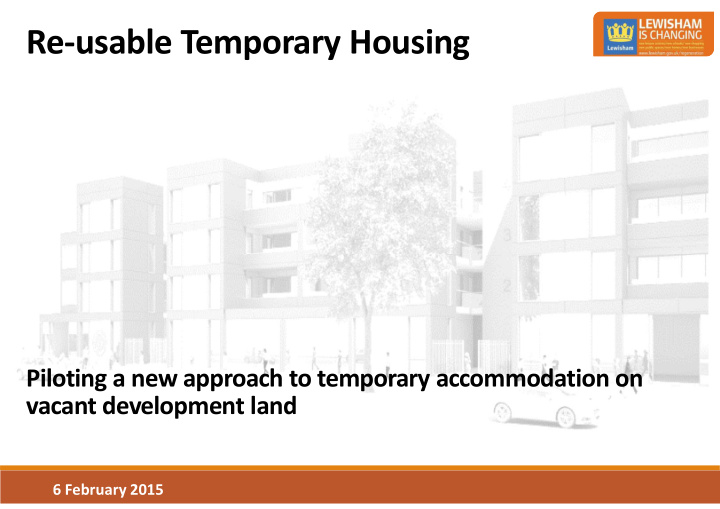



Re-usable Temporary Housing Piloting a new approach to temporary accommodation on vacant development land 6 February 2015
Context: supply & demand Number of homeless households going into Number of available lets, 2010/11 to temporary accommodation, 2010/11 to 2014/15 2014/15 (projected) (at January) 1,890 1,822 Down by 43% Up by 76% 1,756 1,562 1,441 1,219 1,085 TOTAL 1,188 1,089 924 1,350 1,055 831 Re-lets New build 212 254 164 (rent) 2010/11 2011/12 2012/13 2013/14 2014/15 2010/11 2011/12 2012/13 2013/14 2014/15 2
The biggest gap… Lettings performance - (reported monthly) Housing register (HR) analysis Bed size (E) Studio 1 2 3 4+ Total Applicants on housing register - 2014/15 ytd 4 1,965 3,309 2,377 965 8,620 Homeless on HR - 2014/15 ytd 0 91 776 235 105 1,207 % Homeless on HR - 2014/15 ytd 14.0% Households in nightly paid by bed size required - 2014/15 (F) Accommodation required 1 bed 2 bed 3 4 bed 5+ bed Total 88 299 155 27 10 Grand total 579 Bed size (G) YTD Lets by bed size Studio 1 2 3 4+ Total Lets to homeless on HR 0 27 115 43 19 204 Lets to other rehousing reasons 28 239 79 64 9 419 3 Total lets 28 266 194 107 28 623 Lets to families for all rehousing reasons 194 107 28 329 Total Lets by bed size - 2013/14 79 450 437 199 54 1,219
Context: our response 4
Three questions 1.What is the quickest way of meeting this demand? 2.How do we maximise the use of vacant and valuable land? 3.How can we do that in a “regenerative” way, to drive interest and footfall, and signal our intent? 5
New technology, re-usable housing •Homes built off-site using modern construction technologies •Homes designed around the product, rather than generic design and build •Lower costs, and cost certainty •Shorter deployment programme, fewer programme risks … •Housing “production line” •New technologies enable construction, de-construction and 6 re-construction
In theory, can help in a number of ways… 1.Deploy structures onto vacant sites while longer term plans are being developed 2. Create flexible structures for a range of future uses 3.Enable on-site decant on regeneration schemes 4.Use modern methods as part of our new homes build programme 7
Making the case • Engaged market leading specialists across more than one field: • Rogers Stirk Harbour to lead a design feasibility exercise on a given site • SIG systems to provide technical feasibility and structural design input based on their patented InsuShell model • Brief: on this site, advise on how a modern method of construction could meet the objectives as set out previously 8
Rogers Stirk Harbour • Pre-eminent UK architect with a strong focus on affordable housing and inner city regeneration • Developed the “HomeShell” concept home which was constructed within 24 hours and can be redeployed. • Working with YMCA Merton to develop the model further to create the “Y-Cube” one bed home 9
Sheffield Insulation Group • FTSE 250 listed company with revenue of £1.2bn in 2013, and holds patent for InsuShell. • Delivered Olympic Velodrome, and moving into housing with “House” development for Urban Splash 10
The proposal 11
The homes 12
Enterprise hub 13
“Re-usability” 14
Cost and return on investment •Build costs •Units: £1,200 per sqm, £105k per unit •Total build including landscaping and ground floor, £131k per unit •Income •Estimated savings per unit by taking families out of B&B = £20k (£2m/4 years) •Estimated net rent per unit £5,000 (£0.5m/4 years) •Cost of move •c£800k •Generates £4m benefit to Council over 30 years, OR •Pays for itself in 8 years •This assumes no income on commercial units, no external support or sponsorship, no 15 alternative rental types (i.e. could be PRS in the future).
Programme •Decision to proceed: October 14 •Planning submission: February 15 •Planning consent, contractor appointment, handover: May 15 •Assembly: July – September •Residential units occupied: November •Commercial units occupied: January 16 •Scheme moves to another location: 2019 16
Any questions? 17
Recommend
More recommend